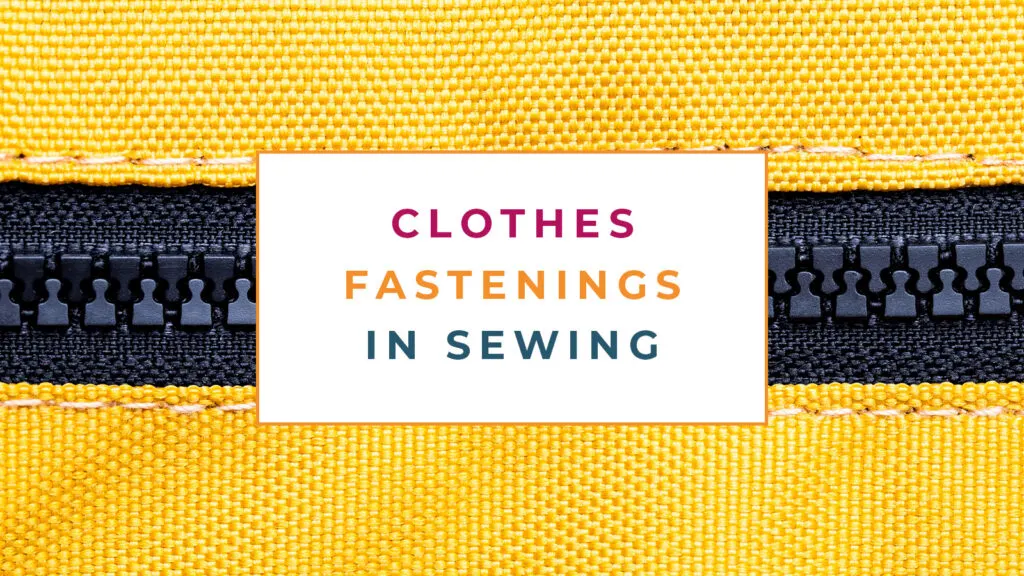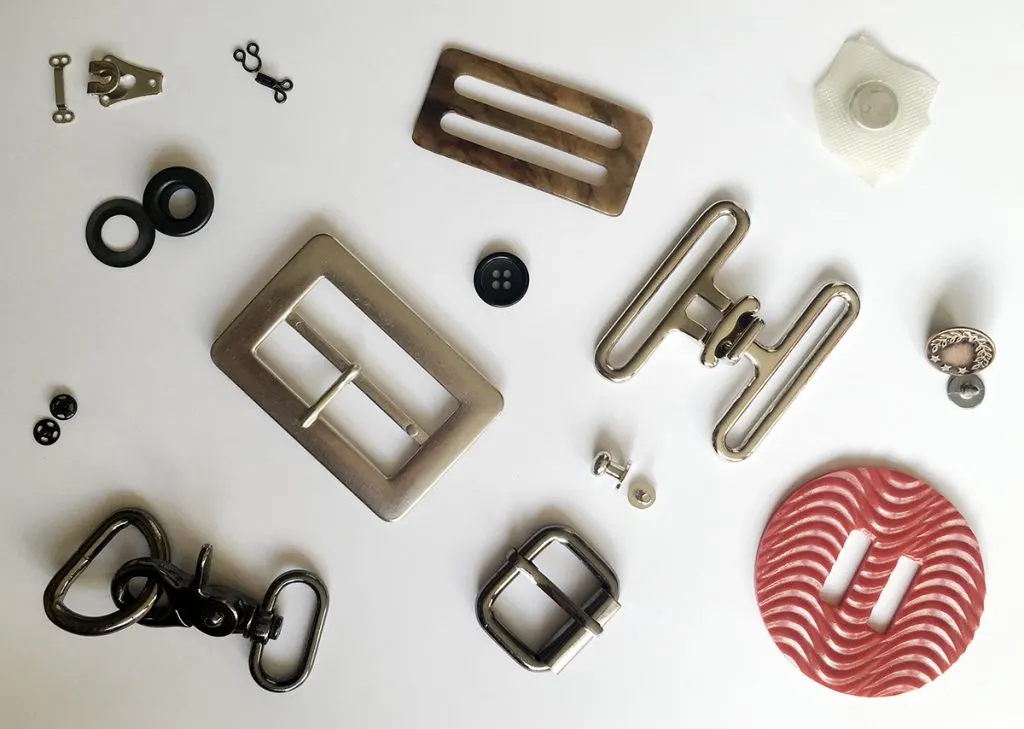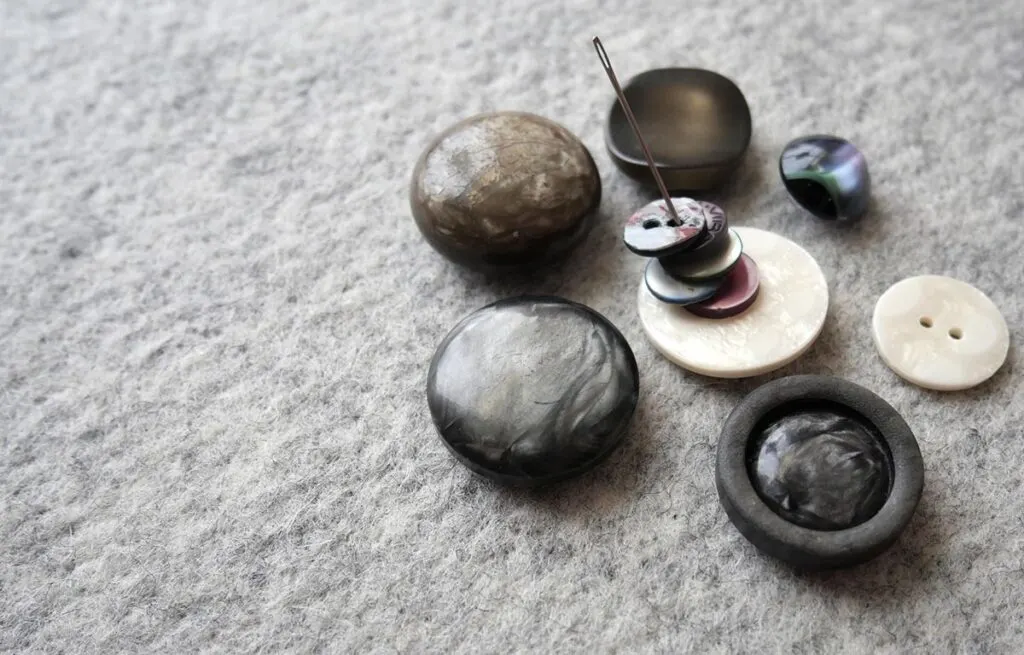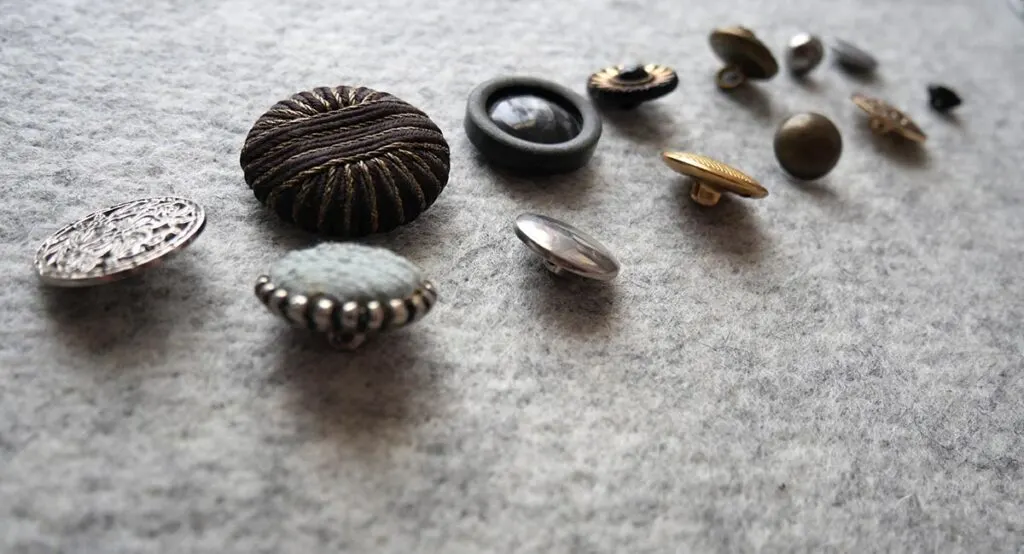With more and more people around the world deciding to learn sewing in order to sew their own clothes, knowing the different ways that a garment can be fastened is important.
Today, you’re going to learn about the different clothes fastenings that can be used across the many types of clothing, whether to fasten a collar on a garment or the entire front of a coat or jacket.
From zippers and buttons through to magnets and frogging, there are so many options available to us to use as closures – let’s dive in and take a closer look at them all!
Some of the links in this article are affiliate links. This means that I may receive a fee at no extra cost to you if you purchase a recommended product. I only recommend items I have experience with.

What Are The Different Types Of Clothes Fastenings?
When it comes to creating a garment – for yourself or as a fashion item for someone – as well as thinking about how it looks, we need to also consider how we will get in and out of it, how it will be ‘closed’.
If it is a shirt or a skirt, the obvious answer would be to use buttons or a zipper, but there are other fastenings that we can use and they can be used in different areas of a garment!
What Are Fastenings?
Fastenings are the ‘elements’ used to fasten garments so that they stay closed. As I mentioned above, zippers come as standard on trouser flies, and buttons on shirts, but there are many other types of fastenings and choosing which to use really depends on the garment type you are planning to make and the fabric you intend to use.
The last point is important! You wouldn’t install a heavy metal zipper on a silk chiffon shirt and nor would you add dainty fabric covered buttons as a fastening choice on a leather biker jacket. The fastening you choose to use should work with the fabric you plan to use.
Which Types Of Garments Use Fasteners?

The first that comes to mind when thinking of the different types of clothes that use fastenings are the more fitted variety, often made from woven fabrics, which have very little – if any – stretch in the fabric:
- Button down shirts
- Blouses
- Bras
- Coats
- Corsets
- Dresses
- Jackets
- Pants / trousers
- Skirts
There are also garments made from knitted fabrics that also use fasteners, such as cardigans using buttons and jumpers or hoodies with a zippered placket opening.
Clothing Fasteners: The Types
There are many types of clothing fasteners and within each category, there are variations, so whilst this is a list of 21 types of fastenings for clothing, the number of options are vast!
This is a great list to scan through if you’re looking for zipper alternatives, so, let’s take a quick look at the list before I explain more about the options for types of closures on clothing further down!
- Brooches
- Button
- Buckle
- Clasps
- Eyelet
- Fabric ties
- Frog closure
- Grommets
- Hook and eyes
- Laces
- Loop fastener
- Magnets
- Pin
- Poppers
- Press stud
- Safety pins
- Studs
- Snap fasteners
- Toggles
- Velcro (hook and loop tape)
- Zipper
As you can see, plenty of clothing closure types there to choose from! I am working on more in depth guides to all of the above and will link to existing articles that will provide more information.
Let’s take a more in depth look at each.
Different Types Of Buttons

Let’s start with the different types of buttons used in sewing first before we dig a little deeper into all the other fastenings types!
Buttons are the first thing we think of when it comes to fastenings for our clothing – quickly followed by zippers! There are millions manufactured each year, and they are so easy to come by.
You can buy them brand new or you can repurpose old buttons from existing clothing that is booming a tad too worn out. And then there are plenty of vintage buttons available to buy on marketplaces like Etsy as well.
Compared to when they were first invented, there are many different types of buttons to choose from.
In fact, originally buttons were used more for decoration than function. It was in the 13th century when buttons were really put to use as functional garment fasteners.
And whilst some of the very first buttons were crafted from shell, in the 21st century they’re more likely to be mass manufactured from plastic, metal or wood.
Flat Buttons

Most buttons you find on fashion garments are flat buttons. These lie flat against the fabric and generally have two or four holes in the center that the needle and thread are passed through.
These types of buttons are easy to sew on, either by hand or by machine if your sewing machine type allows for it, and come in a huge variety of materials, from plastic and wood, to metal, glass and ceramic too!
- Two holed buttons usually have the holes lined up parallel to the fastening edge.
- Four holed buttons are stronger than two holed buttons. They work well for heavier fabrics.
Shanked Buttons

On a date with my partner, not long after we met back in 2014, he told me about how his favorite jacket had too many buttons missing and he’d have to stop wearing it.
I asked him to pass it to me, and after giving the jacket the once over I said with a saucy wink, ‘Aha, I can shank your buttons for you!’
Our date continued as they do.
A few weeks later, he told me about his mum’s reaction when he’d said to her that I would shank his buttons for him – she looked at him aghast! He still thinks that was the reason it took his parents so long to invite me for a visit! 🙂
The shank of a shank button is like a stem, with the button the flower on top. Shanking a button is only possible by hand. They cannot be machined on.
Cloth Buttons
Cloth buttons are also shanked, having no visible holes to sew through. They can be flat or rounded and are covered with fabric, which is either solid in color or with a matching or contrasting printed fabric.
It is in fact possible to make your own cloth covered buttons, which is what I did to add a more unique look to my fanny pack.
Toggles
How I remember toggles from my old school coats! Duffle coats and kids clothing are firm favorites to add the traditional toggle fastenings to clothes.
While traditional style toggles are buttons in their own right, they are longer and skinnier, with two holes for attaching them to cord and then onto fabric.
Sometimes the toggle edges are rounded, and sometimes not. They are fed through a loop rather than a button hole.
You can also buy toggles with leather sew on sections to use as coat fasteners!
Toggle fasteners for clothing can be considered much more of a statement fastening than regular buttons! What if you were to cover your toggles with a fabric first? The contrast against the garment fabric could be quite a statement!
As well as the standard traditional type of toggle, there are also more modern plastic versions, also known as ‘cord locks’.
These are a type of fastening – they are usually available in clear, black or colored plastic – that are used on garments that have a self-fitting option.
Usually used on:
- Hems of coats and jackets
- Waist channels of coats
- Bag closures
If you enjoyed this section on buttons, then you might love my more in-depth article covering the different types of buttons used in sewing!
Other Clothes Fastenings!
There’s so much more to fastening fabric than just buttons though, so let’s look at other types of fabric fasteners – button alternatives that are great to use instead of buttons!
Stud Buttons For Clothing

Snap buttons for clothing are also known as jeans buttons. These buttons are ‘studded’ so no needle and thread required and are a great way to add ‘no sew’ fastenings and make great alternatives to buttons!
Snap buttons have a pin which is used to pierce the fabric and is ‘pushed’ into the button part, sandwiching the fabric and securing the two pieces together.
Mostly used on denim and heavy cottons, as they are too heavy for finer fabrics, and would drag the fabric out of shape.
You can also get jean button kits which come with the tool – saves you having to figure out how to attach them yourself!
Snap Fasteners And Poppers

Modern snap fasteners for clothing were originally envisaged by a German inventor in 1885. It was a ‘novelty fastener’ for men’s trousers.
However, they only really came into fashion in 1950s America, when they were used to decorate embroidered and fringed shirts for the stage.
Snaps are made up of rivets so they are stronger and work well for an easy on – easy off garment. Shirts, baby-grows, bags… Oh, and the aforementioned western shirts all use snaps.
When the two sections are joined together they make a ‘snap’ sound, hence the name.
Personally, I hate the original poppers – also called sew on snap fasteners. I think they’re pesky little things which require an awful lot of hand stitching to make sure they are securely attached.
Nowadays you can buy snap fastener kits that come with a tool for easy application!
Hook and Eye

A hook and eye is literally that. A metal hook, which catches on the metal eye.
They first appeared back in the 14th century. Used as an invisible button on English doublets and breeches, they were originally made by hand out of wire.
Today’s version was created in the 19th century and patented in 1900.
To use them well, there does need to be some tension; if the fabric is not held taught, they’ll pop loose.
That said, they are also used in the tops of skirts and dresses above a concealed zipper, offering an added layer of security just in case the zipper were to try to slide down.
Hooks and eyes are also used in bra’s and sometimes corsets which have no lacing.
Types Of Zippers As Garment Fasteners
The first zip as we know it today was invented in 1913 by electrical engineer Gideon Sundback, though it was in 1851 that the first patent for an ‘automatic continuous clothing closure’ was filed.
Zippers come in all sorts of shapes, sizes and materials, and are used on everything from clothing to bags to tents and upholstery covers.
Zip fastenings really are the most easy to use fastening for clothes, and as there are several different types of zippers used in sewing, choosing the right one to use will depend on the garment you are sewing.
- Coil zippers
- Metal zippers
- Concealed zippers – also referred to as invisible zippers, you’ll need a zipper foot to sew these!
- Separating / open ended zippers – these are used on coats, jackets, etc that need to be fully openable.
- Two way separating zippers
An Invisible Zipper – See how the zip teeth are invisible when closed?

An Invisible Zipper – The teeth are now ‘just’ visible when the zipper is open
An open ended plastic zipper
Check out these six methods for sewing zippers too!
Buckles
Roman soldiers used to use ‘buccula’ to keep their helmets and body armor in place.
The word translates from Latin into strap, and a buckle fastening would have been necessary to keep the straps where they needed to be.
Below you can see a photo of old plastic buckles – these would have fabric belts passed through the holes.
The earliest buckles were forged from bronze and used only by soldiers for some years. Their use then passed down to the wealthy until the 15th century.
At this time, there were better manufacturing techniques and so many more buckles could be made at a lower cost. Not unlike today’s mass production!
Buckle fastenings are found nowadays on belts, bags, coats and as more contemporary fastenings on other fashion items. They are also no longer restricted to only being made of metal.

Buckle fastenings have been made from many other materials through the years including wood, pearl, plastics and glass.
Metal Buckles – the more traditional kind!

A new style of buckle? Definitely a great way to close a heavy jacket?

Hook & Loop (Velcro)

Velcro – also known as hook and loop tape – was invented back in 1951 so a relatively recent invention!
Using two strips, one of nylon hooks and one of nylon loops, these strips are stitched into place. When pressed together they stick, and need to be ‘ripped’ apart.
Hook and eye tape is a fabric fasteners, and comes in different widths:
It is possible to attach Velcro to fabric without sewing, but stitching it in place makes for a more secure velcro fastening.
Used on kiddies shoes, water tight garments (wetsuits etc) and in theater for easy changes, velcro is not ordinarily something you would use for general fashion garments.
That said, it has come into its own for innovative use, the most famous being used to hold together a human heart during the first ever artificial heart surgery!
If you have a garment using velcro and want to switch it out, I wrote about the best three alternatives to velcro!
Frog Closure
A frogging fastening – or a frog fastener as it is often called – is a braided loop fastening seen mostly on the fronts of Asian style garments.
Designed more as a decorative fastener for clothes, frogging is essentially shaped fabric tubes and the ‘frog’ part is the ‘button’ that goes through the frogging loop.
It is often paired with a mandarin collar. Learn how to draft a mandarin collar here!
Grommets And Eyelets

Grommets are plastic or metal rings, used to reinforce holes in the fabric you’re using.
Ribbon, lace or cord can then be passed through, lacing the two sides together, just like in a corset. The grommet hole is called an eye.
To install grommets or eyelets, you’ll need a special tool – this one is heavy duty and takes all the effort out or there’s this fab handheld tool from Dritz! – but you can also buy grommet kits.
You’ll also need to pierce holes in the fabric first, and this tool has some great reviews!
If you want to learn how to put eyelets or grommets into fabric, this post is the best step by step tutorial!
Brooches
Brooches are primarily intended nowadays as a decorative closure, utilizing a catch and a pin, which you fasten to cloth, like a safety pin.
Normally embellished or made of metal, they can add a nice touch as clothes fastenings if used in the right way.
Historically, the brooch was one of the earliest fastenings to be introduced in Europe. Small brooches would be used to hold together the edges of a neckline slit.
Most often used nowadays on traditional Scottish kilts and the more decorative versions can be found on our grandparents cardigans.
Magnets

A recent addition for clothes fastenings: using special wrapped magnets for clothing closures!
Magnetic fasteners for clothes are becoming more and more common – when I did my fashion degree they were only just being used but are now everywhere!
These sewable magnet fasteners are made of a strong magnet enclosed in small plastic pouches which are then sewn into the garment and hidden by the facing.
Great for when a clean minimal look is required with no visible closures to mar the silhouette.
Magnets would be sewn one piece into each side, hidden by the facing or lining.
Fabric Ties and Laces

Lacing, fabric ties, and cord have all been used through time as a way to fasten a closure in clothing.
Used either to lace something together with grommets or sewn into the edge of the opening and tied together, this is a nice clothes fastenings if you do not want to use buttons or other hardware.
If making fabric ties yourself, it would be good to practice the art of making rouleau tubing.
Ideally using soft fabrics, they should be cut on the bias to ensure a smooth finish and your can use this loop turning tool to turn through for beautiful rouleau loops!
So, there you have it. 15 different clothes fastenings to think about when designing your next fashion creation. Can you think of anything I have missed? Pop your ideas in the comments box below!
Here’s a quick link to a more succinct story on the types of fastening used in sewing that you can save for another time!

Alinda Free
Monday 17th of August 2020
I am looking for a soft, short loop velcro fastners used for baby clothes and accessories, ie bibs etc. I see them on cheap $$Tree bibs! I ordered what looked like it, but was still not that soft. Any recommendaiions??
Eve Tokens
Thursday 10th of September 2020
Hi Alinda! This is the only version I know of - https://www.velcro.com/products/halloween/900205__sew-on-soft-flexible - that is softer than regular Velcro! Hope this is helpful!
Kizzy
Saturday 18th of July 2020
Any ideas on an alternative fastening for a reversible zip in a reversible skirt? I have a shop bought reversible skirt I want to replicate. It has a side seam with reversible 20cm zip to fasten but I can’t find that length or style of zip anywhere.
Eve Tokens
Tuesday 28th of July 2020
Het Kizzy! Where are you located? There's an amazing place in Whitechapel in London that I used to get my best zips from, but not sure if they ship at the moment. Otherwise, if you wanted it to be reversible, you could try rouleau loops sandwiched the same way you would sandwich a reversible zipper, and then lace the opening through the loops. Not the fastest opening to create (or use) though!
Isabelle Buxton-Smith
Monday 16th of September 2019
Hi I think that the Velcro is the best option for a fastener. It is easy to put on and it stays PUT!!!!
Eve Tokens
Thursday 3rd of October 2019
Hi Isabelle! Thanks for taking the time to comment! Velcro! I have to agree that it is easy to put on - my trouble with it through Isabelle is that the few items I have with velcro (looking at you raincoat!) always snag on other clothes and end up pulling and trashing the fibres. Sob!
Deryk Jones
Wednesday 10th of July 2019
On the picture you show a fastening in the centre of three buckles and a button. I am trying to find that particular item but for the life of me I cannot find one. I don’t know what the item is called, can you help? I would be very grateful if you can.
Sincere Regards, Deryk
derykajones@hotmail.com
Char Char
Saturday 29th of August 2020
Magnetic wouldn't these affect the washing machine?